Influence of Deposition Temperature on Microstructure and Properties of Tantalum Oxide Sputtered Coatings
Abstract
1. Introduction
2. Materials and Methods
2.1. Substrate Material and Initial Preparation
2.2. Coating Deposition
2.3. Characterisation
3. Results and Discussions
3.1. Structural and Chemical Characterisation of the Deposited Films
3.2. Mechanical Properties of the Coated Systems
3.3. Wettability
3.4. Electrochemical Tests
3.4.1. Open Circuit Potentials
3.4.2. Potentiodynamic Polarisation Tests
3.4.3. Electrochemical Impedance Spectroscopy (EIS)
3.4.4. Equivalent Electrical Circuit Models
3.5. Immersion Test in SBF Solution for 7 Days and Analysis of the Solution Chemistry
3.6. Shortcomings of the Research
4. Conclusions
Author Contributions
Funding
Institutional Review Board Statement
Informed Consent Statement
Data Availability Statement
Conflicts of Interest
References
- Prasad, S.; Ehrensberger, M.; Gibson, M.P.; Kim, H.; Monaco, E.A. Biomaterial properties of titanium in dentistry. J. Oral Biosci. 2015, 57, 192–199. [Google Scholar] [CrossRef]
- Geetha, M.; Singh, A.K.; Asokamani, R.; Gogia, A.K. Ti based biomaterials, the ultimate choice for orthopaedic implants—A review. Prog. Mater. Sci. 2009, 54, 397–425. [Google Scholar] [CrossRef]
- Kuromoto, N.K.; Simão, R.A.; Soares, G.A. Titanium oxide films produced on commercially pure titanium by anodic oxidation with different voltages. Mater. Charact. 2007, 58, 114–121. [Google Scholar] [CrossRef]
- Portan, D.V.; Kroustalli, A.A.; Deligianni, D.D.; Papanicolaou, G.C. On the biocompatibility between TiO2 nanotubes layer and human osteoblasts. J. Biomed. Mater. Res. A 2012, 100, 2546–2553. [Google Scholar] [CrossRef]
- Javed, F.; Romanos, G.E. Impact of diabetes mellitus and glycemic control on the osseointegration of dental implants: A systematic literature review. J. Periodontol. 2009, 80, 1719–1730. [Google Scholar] [CrossRef]
- Nine, M.J.; Choudhury, D.; Hee, A.C.; Mootanah, R.; Osman, N.A.A. Wear debris characterization and corresponding biological response: Artificial hip and knee joints. Materials 2014, 7, 980–1016. [Google Scholar] [CrossRef] [PubMed]
- Rae, T. The biological response to titanium and titanium-aluminium-vanadium alloy particles. Biomaterials 1986, 7, 30–36. [Google Scholar] [CrossRef] [PubMed]
- Khadija, G.; Saleem, A.; Akhtar, Z.; Naqvi, Z.; Gull, M.; Masood, M.; Mukhtar, S.; Batool, M.; Saleem, N.; Rasheed, T.; et al. Short term exposure to titanium, aluminum and vanadium (Ti 6Al 4V) alloy powder drastically affects behavior and antioxidant metabolites in vital organs of male albino mice. Toxicol. Rep. 2018, 5, 765–770. [Google Scholar] [CrossRef]
- Oliveira, V.M.C.A.; Aguiar, C.; Vazquez, A.M.; Robin, A.; Barboza, M.J.R. Improving corrosion resistance of Ti–6Al–4V alloy through plasma-assisted PVD deposited nitride coatings. Corros. Sci. 2014, 88, 317–327. [Google Scholar] [CrossRef]
- Meng, F.; Li, Z.; Liu, X. Synthesis of tantalum thin films on titanium by plasma immersion ion implantation and deposition. Surf. Coat. Technol. 2013, 229, 205–209. [Google Scholar] [CrossRef]
- Niinomi, M. Mechanical biocompatibilities of titanium alloys for biomedical applications. J. Mech. Behav. Biomed. Mater. 2008, 1, 30–42. [Google Scholar] [CrossRef]
- Soro, N.; Attar, H.; Brodie, E.; Veidt, M.; Molotnikov, A.; Dargusch, M.S. Evaluation of the mechanical compatibility of additively manufactured porous Ti–25Ta alloy for load-bearing implant applications. J. Mech. Behav. Biomed. Mater. 2019, 97, 149–158. [Google Scholar] [CrossRef]
- Weisman, S. Metals for implantation in the human body. Ann. N. Y. Acad. Sci. 1968, 146, 80–95. [Google Scholar] [CrossRef] [PubMed]
- Shiri, S.; Zhang, C.; Odeshi, A.; Yang, Q. Growth and characterization of tantalum multilayer thin films on CoCrMo alloy for orthopaedic implant applications. Thin Solid Films 2018, 645, 405–408. [Google Scholar] [CrossRef]
- Rahmati, B.; Sarhan, A.A.D.; Zalnezhad, E.; Kamiab, Z.; Dabbagh, A.; Choudhury, D.; Abas, W.A.B.W. Development of tantalum oxide (Ta-O) thin film coating on biomedical Ti-6Al-4V alloy to enhance mechanical properties and biocompatibility. Ceram. Int. 2016, 42, 466–480. [Google Scholar] [CrossRef]
- Rahmati, B.; Sarhan, A.A.D.; Basirun, W.J.; Abas, W.A.B.W. Ceramic tantalum oxide thin film coating to enhance the corrosion and wear characteristics of Ti6Al4V alloy. J. Alloys Compd. 2016, 676, 369–376. [Google Scholar] [CrossRef]
- Almeida Alves, C.F.; Cavaleiro, A.; Carvalho, S. Bioactivity response of Ta1-xOx coatings deposited by reactive DC magnetron sputtering. Mater. Sci. Eng. C 2016, 58, 110–118. [Google Scholar] [CrossRef]
- Xu, G.; Shen, X.; Hu, Y.; Ma, P.; Cai, K. Fabrication of tantalum oxide layers onto titanium substrates for improved corrosion resistance and cytocompatibility. Surf. Coat. Technol. 2015, 272, 58–65. [Google Scholar] [CrossRef]
- Metikoš-Hukovi’c, M.; Kwokal, A.; Piljac, J. The influence of niobium and vanadium on passivity of titanium-based implants in physiological solution. Biomaterials 2003, 24, 3765–3775. [Google Scholar] [CrossRef]
- Beline, T.; da Silva, J.H.D.; Matos, A.O.; Azevedo Neto, N.F.; de Almeida, A.B.; Nociti Júnior, F.H.; Leite, D.M.G.; Rangel, E.C.; Barão, V.A.R. Tailoring the synthesis of tantalum-based thin films for biomedical application: Characterization and biological response. Mater. Sci. Eng. C. 2019, 101, 111–119. [Google Scholar] [CrossRef]
- Zhang, X.-M.; Li, Y.; Gu, Y.-X.; Zhang, C.-N.; Lai, H.-C.; Shi, J.-Y. Ta-Coated Titanium Surface with Superior Bacteriostasis And Osseointegration. Int. J. Nanomed. 2019, 14, 8693–8706. [Google Scholar] [CrossRef]
- Chang, Y.Y.; Huang, H.L.; Chen, H.J.; Lai, C.H.; Wen, C.Y. Antibacterial properties and cytocompatibility of tantalum oxide coatings. Surf. Coat. Technol. 2014, 259, 193–198. [Google Scholar] [CrossRef]
- Sun, Y.S.; Chang, J.H.; Huang, H.H. Corrosion resistance and biocompatibility of titanium surface coated with amorphous tantalum pentoxide. Thin Solid Films 2013, 528, 130–135. [Google Scholar] [CrossRef]
- Zein El Abedin, S.; Welz-Biermann, U.; Endres, F. A study on the electrodeposition of tantalum on NiTi alloy in an ionic liquid and corrosion behaviour of the coated alloy. Electrochem. Commun. 2005, 7, 941–946. [Google Scholar] [CrossRef]
- Balla, V.K.; Banerjee, S.; Bose, S.; Bandyopadhyay, A. Direct laser processing of a tantalum coating on titanium for bone replacement structures. Acta Biomater. 2010, 6, 2329–2334. [Google Scholar] [CrossRef]
- Anbalagan, A.K.; Cummings, R.; Zhou, C.; Mun, J.; Stanic, V.; Jordan-Sweet, J.; Yao, J.; Kisslinger, K.; Weiland, C.; Nykypanchuk, D.; et al. Revealing the Origin and Nature of the Buried Metal-Substrate Interface Layer in Ta/Sapphire Superconducting Films. Adv. Sci. 2025, 2413058. [Google Scholar] [CrossRef] [PubMed]
- Bend, A.; Kandadai, V.A.S.; Petersen, J.B.; Jasthi, B.K. Effect of deposition pressure on the microstructure, mechanical, and corrosion properties of tantalum nitride thin films deposited by reactive pulsed laser deposition. Vacuum 2025, 238, 114228. [Google Scholar] [CrossRef]
- Tian, X.; Ding, Y.; Chai, G.; Tang, Y.; Lei, R.; Jia, G.; Zhang, Y.; Li, J.; Zhou, Y.; Wang, X. Plasma-Enhanced Atomic Layer Deposition of Amorphous Tantalum Thin Films for Copper Interconnects Using an Organometallic Precursor. Adv. Mater. Technol. 2024, 9, 2301541. [Google Scholar] [CrossRef]
- Yang, X.; Gao, M.; Liu, Y.; Li, J.; Huang, Y.; Wang, G. Superior corrosion resistance of high-temperature Ir–Ni–Ta–(B) amorphous alloy in sulfuric acid solution. Corros. Sci. 2022, 200, 110227. [Google Scholar] [CrossRef]
- Song, B.; Hua, Y.; Zhou, C.; Li, Y.; Yang, L. Fabrication and anticorrosion behavior of a bi-phase TaNbHfZr/CoCrNi multilayer coating through magnetron sputtering. Corros. Sci. 2022, 196, 110020. [Google Scholar] [CrossRef]
- Khalil-Allafi, J.; Daneshvar, H.; Safavi, M.S.; Khalili, V. A survey on crystallization kinetic behavior of direct current magnetron sputter deposited NiTi thin films. Phys. B Condens. Matter 2021, 615, 413086. [Google Scholar] [CrossRef]
- Bright, T.J.; Watjen, J.I.; Zhang, Z.M.; Muratore, C.; Voevodin, A.A.; Koukis, D.I.; Tanner, D.B.; Arenas, D.J. Infrared optical properties of amorphous and nanocrystalline Ta2O5 thin films. J. Appl. Phys. 2013, 114, 083515. [Google Scholar] [CrossRef]
- Li, J.; Liu, W.; Wei, Y.; Yan, Y. Effect of Oxygen Content on the Properties of Sputtered TaOx Electrolyte Film in All-Solid-State Electrochromic Devices. Coatings 2022, 12, 1831. [Google Scholar] [CrossRef]
- Wu, S.J.; Houng, B.; Huang, B. Effect of growth and annealing temperatures on crystallization of tantalum pentoxide thin film prepared by RF magnetron sputtering method. J. Alloys Compd. 2009, 475, 488–493. [Google Scholar] [CrossRef]
- Narayanan, R.; Seshadri, S.K.; Kwon, T.Y.; Kim, K.H. Calcium phosphate-based coatings on titanium and its alloys. J. Biomed. Mater. Res. B 2008, 85, 279–299. [Google Scholar] [CrossRef] [PubMed]
- Macionczyk, F.; Gerold, B.; Thull, R. Repassivating tantalum/tantalum oxide surface modification on stainless steel implants. Surf. Coat. Technol. 2001, 142–144, 1084–1087. [Google Scholar] [CrossRef]
- Sahoo, K.K.; Pradhan, D.; Ghosh, S.P.; Gartia, A.; Kar, J.P. Modulation of electrical properties of sputtered Ta2O5 films by variation of RF power and substrate temperature. Phys. Scr. 2024, 99, 025934. [Google Scholar] [CrossRef]
- Yamada, A.; Sang, B.; Konagai, M. Atomic layer deposition of ZnO transparent conducting oxides. Appl. Surf. Sci. 1997, 112, 216–222. [Google Scholar] [CrossRef]
- Almeida Alves, C.F.; Mansilla, C.; Pereira, L.; Paumier, F.; Girardeau, T.; Carvalho, S. Influence of magnetron sputtering conditions on the chemical bonding, structural, morphological and optical behavior of Ta1−xOx coatings. Surf. Coat. Technol. 2018, 334, 105–115. [Google Scholar] [CrossRef]
- Ohring, M. Materials Science of Thin Films: Deposition and Structure, 2nd ed.; Academic Press: Boston, MA, USA, 2002; p. 221. [Google Scholar] [CrossRef]
- Martin, N.; Cote, J.-M.; Gavoille, J.; Potin, V. Tantalum Oxide Thin Films Sputter-Deposited by Oxygen Gas Pulsing. Coatings 2023, 13, 1932. [Google Scholar] [CrossRef]
- Favaro, G.; Milotti, V.; Diaz Riega, D.A.; Busdon, N.; Bazzan, M.; Granata, M.; Hofman, D.; Michel, C.; Pinard, L.; Conti, L.; et al. Reduction of mechanical losses in ion-beam sputtered tantalum oxide thin films via partial crystallization. Class. Quantum Grav. 2024, 41, 105009. [Google Scholar] [CrossRef]
- Heinrichs, J.; Jarmar, T.; Wiklund, U.; Engqvist, H. Physical Vapour Deposition and Bioactivity of Crystalline Titanium Dioxide Thin Films. Engqvist Artif. Organs Trends Biomater. Artif. Organs. 2008, 22, 104–110. [Google Scholar]
- Guisbiers, G.; Herth, E.; Buchaillot, L.; Pardoen, T. Fracture toughness, hardness, and Young’s modulus of tantalum nanocrystalline films. Appl. Phys. Lett. 2010, 97, 143115. [Google Scholar] [CrossRef]
- Xu, J.; Hua, W.; Xie, Z.-H.; Munroe, P. Reactive-sputter-deposited β-Ta2O5 and TaON nanoceramic coatings on Ti–6Al–4V alloy against wear and corrosion damage. Surf. Coat. Technol. 2016, 296, 171–184. [Google Scholar] [CrossRef]
- Li, H.; Ding, Y.; Hu, X.; Li, W.; Ding, Z. A comparative study of TiO2, Ta2O5 and Nb2O5 coated Ti6Al4V titanium alloy for biomedical applications. Ceram. Int. 2024, 50, 50444–50453. [Google Scholar] [CrossRef]
- Davis, C.A. A simple model for the formation of compressive stress in thin films by ion bombardment. Thin Solid Films 1993, 226, 30–34. [Google Scholar] [CrossRef]
- Wang, L.; Aversa, R.; Houa, Z.; Tian, J.; Liang, S.; Ge, S.; Chen, Y.; Perrotta, V.; Apicella, A.; Apicella, D.; et al. Bioresorption control and biological response of magnesium alloy AZ31 coated with poly-β-hydroxybutyrate. Appl. Sci. 2021, 11, 5627. [Google Scholar] [CrossRef]
- Gittens, R.A.; Scheideler, L.; Rupp, F.; Hyzy, S.L.; Geis-Gerstorfer, J.; Schwartz, Z.; Boyan, B.D. A review on the wettability of dental implant surfaces II: Biological and clinical aspects. Acta Biomater. 2014, 10, 2907–2918. [Google Scholar] [CrossRef]
- Hirpara, J.; Chawla, V.; Chandra, R. Investigation of tantalum oxynitride for hard and anti-corrosive coating application in diluted hydrochloric acid solutions. Mater. Today Commun. 2020, 23, 101113. [Google Scholar] [CrossRef]
- Burstein, G.T.; Souto, R.M. Observations of localised instability of passive titanium in chloride solution. Electrochim. Acta 1995, 40, 1881–1888. [Google Scholar] [CrossRef]
- Bose, S.; Pathak, L.C.; Singh, R. Response of boride coating on the Ti-6Al-4V alloy to corrosion and fretting corrosion behavior in Ringer’s solution for bio-implant application. Appl. Surf. Sci. 2018, 433, 1158–1174. [Google Scholar] [CrossRef]
- Prithivirajan, S.; Nyahale, M.B.; Naik, G.M.; Narendranath, S.; Prabhu, A.; Rekha, P.D. Bio-corrosion impacts on mechanical integrity of ZM21 Mg for orthopaedic implant application processed by equal channel angular pressing. J. Mater. Sci. Mater. Med. 2021, 32, 65. [Google Scholar] [CrossRef] [PubMed]
- Pan, J.; Leygraf, C.; Thierry, D.; Ektessabi, A.M. Corrosion resistance for biomaterial applications of TiO2 films deposited on titanium and stainless steel by ion-beam-assisted sputtering. J. Biomed. Mater. Res. 1997, 35, 309–318. [Google Scholar] [CrossRef]
- Ryl, J.; Wysocka, J.; Slepski, P.; Darowicki, K. Instantaneous impedance monitoring of synergistic effect between cavitation erosion and corrosion processes. Electrochim. Acta 2016, 203, 388–395. [Google Scholar] [CrossRef]
- Boukamp, B.A. Nonlinear Least Squares Fit Procedure for Analysis of Immittance Data of Electrochemical Systems. Solid State Ionics 1986, 20, 31–44. [Google Scholar] [CrossRef]
- Moreto, J.A.; Marino, C.E.B.; Bose Filho, W.W.; Rocha, L.A.; Fernandes, J.C.S. SVET, SKP and EIS study of the corrosion behaviour of high strength Al and Al-Li alloys used in aircraft fabrication. Corros. Sci. 2014, 84, 30–41. [Google Scholar] [CrossRef]
- Ahmed, M.S.; Munroe, P.; Jiang, Z.-T.; Zhao, X.; Rickard, W.; Zhou, Z.; Li, L.K.Y.; Xie, Z. Corrosion behaviour of nanocomposite TiSiN coatings on steel substrates. Corros. Sci. 2011, 53, 3678–3687. [Google Scholar] [CrossRef]
- Zhang, J.; Dai, C.; Wei, J.; Wen, Z.; Zhang, S.; Chen, C. Degradable behavior and bioactivity of micro-arc oxidized AZ91D Mg alloy with calcium phosphate/chitosan composite coating in m-SBF. Colloids Surf. B 2013, 111, 179–187. [Google Scholar] [CrossRef]
- Stiegler, N.; Bellucci, D.; Bolelli, G.; Cannillo, V.; Gadow, R.; Killinger, A.; Lusvarghi, L.; Sola, A. Explore all metrics High-velocity suspension flame sprayed (HVSFS)hydroxyapatite coatings for biomedical applications. J Therm. Spray Technol. 2012, 21, 275–287. [Google Scholar] [CrossRef]
- Rajan, S.T.; Das, M.; Arockiarajan, A. In vitro biocompatibility and degradation assessment of tantalum oxide coated Mg alloy as biodegradable implants. J. Alloys Compd. 2022, 905, 164272. [Google Scholar] [CrossRef]
- Cai, C.; Wang, X.; Li, B.; Dong, K.; Shen, Y.; Li, Z.; Shen, L. Fabrication of hydroxyapatite/tantalum composites by pressureless sintering in different atmosphere. ACS Omega 2021, 6, 12831–12840. [Google Scholar] [CrossRef] [PubMed]
- Hee, A.C.; Zhao, Y.; Jamali, S.S.; Bendavid, A.; Martin, P.J.; Guo, H. Characterization of tantalum and tantalum nitride films on Ti6Al4V substrate prepared by filtered cathodic vacuum arc deposition for biomedical applications. Surf. Coat. Technol. 2019, 365, 24–32. [Google Scholar] [CrossRef]
- Karimi, S.; Nickchi, T.; Alfantazi, A. Effects of bovine serum albumin on the corrosion behaviour of AISI 316L, Co–28Cr–6Mo, and Ti–6Al–4V alloys in phosphate buffered saline solutions. Corros. Sci. 2011, 53, 3262–3272. [Google Scholar] [CrossRef]
- Jemat, A.; Ghazali, M.J.; Razali, M.; Otsuka, Y.; Rajabi, A. Effects of TiO2 on microstructural, mechanical properties and in-vitro bioactivity of plasma sprayed yttria stabilised zirconia coatings for dental application. Ceram Intern. 2018, 44, 4271–4281. [Google Scholar] [CrossRef]
- Pereira, B.L.; Tummler, P.; Marino, C.E.B.; Soares, P.C.; Kuromoto, N.K. Titanium bioactivity surfaces obtained by chemical/electrochemical treatments. Matéria 2014, 19, 16–23. [Google Scholar] [CrossRef]
- Xu, J.; Fu, T.; Lyu, Y.; Munroe, P.; Xie, Z. In vitro biocompatibility of a nanocrystalline β-Ta2O5 coating for orthopaedic implants. Ceram. Int. 2018, 44, 4660–4675. [Google Scholar] [CrossRef]
- Amaravathy, P.; Sowndarya, S.; Sathyanarayanan, S.; Rajendran, N. Novel sol gel coating of Nb2O5 on magnesium alloy for biomedical applications. Surf. Coat. Technol. 2014, 244, 131–141. [Google Scholar] [CrossRef]
- Black, J. Biological Performance of Tantalum. Clin. Mater. 1994, 16, 167–173. [Google Scholar] [CrossRef]

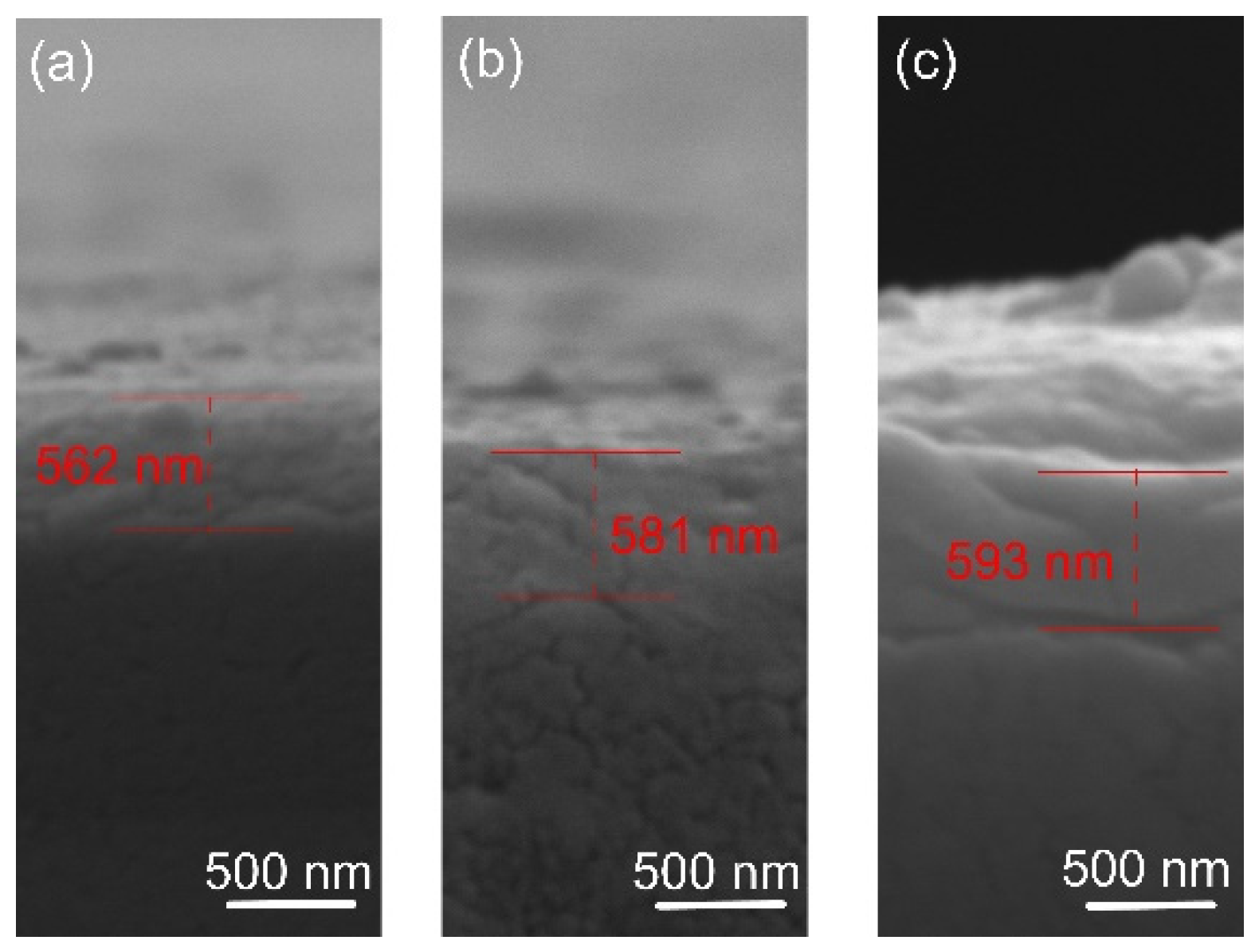

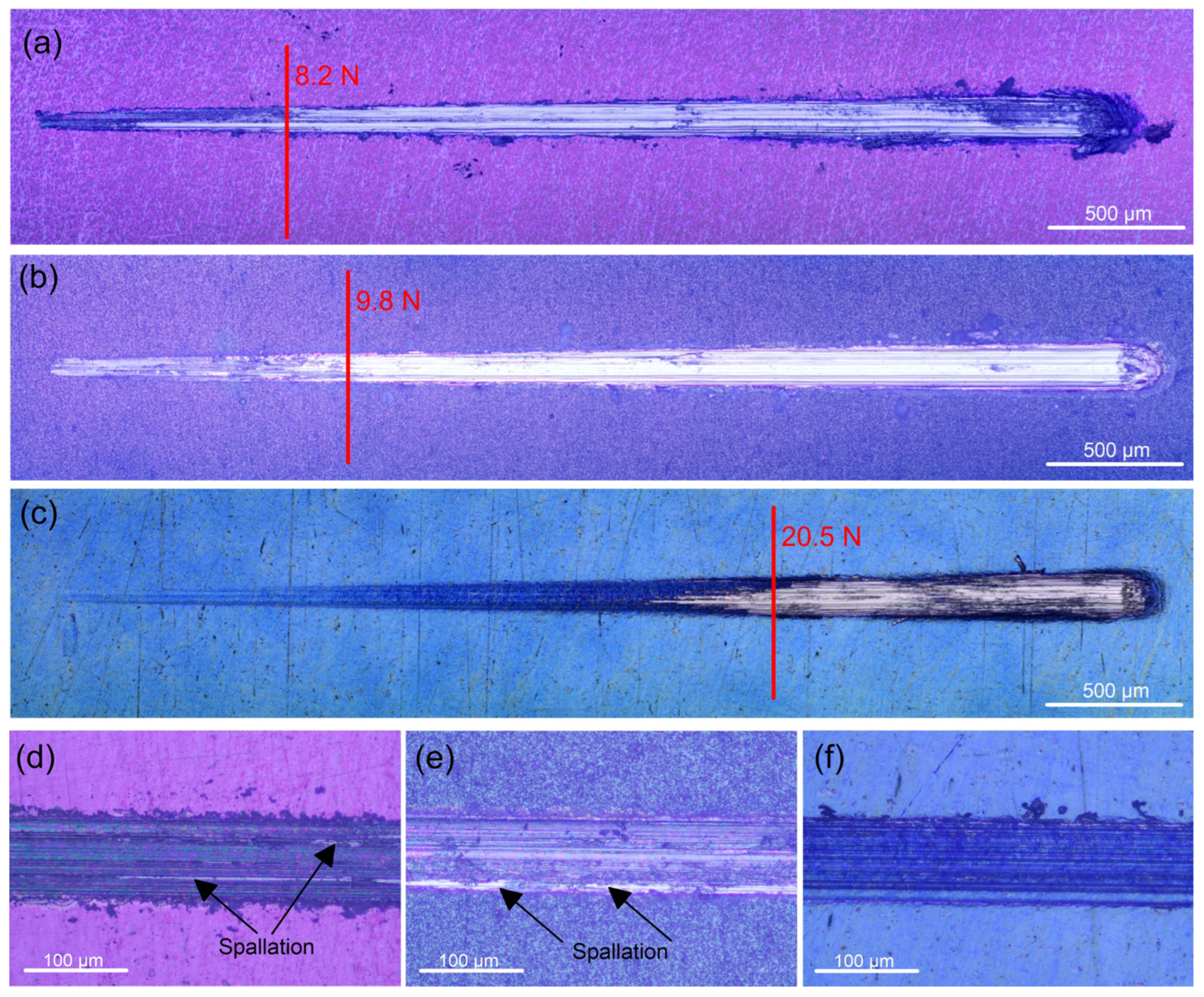

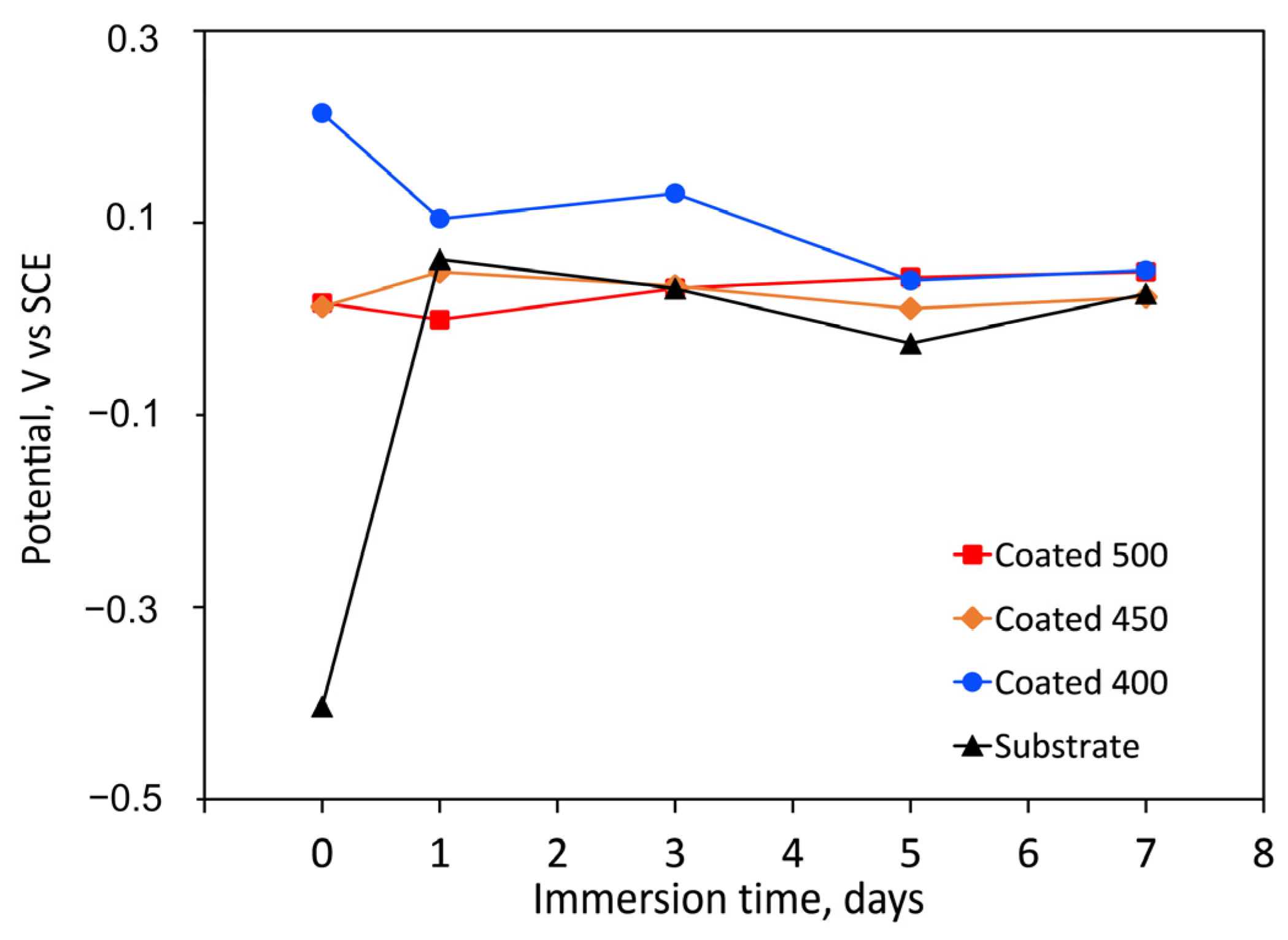
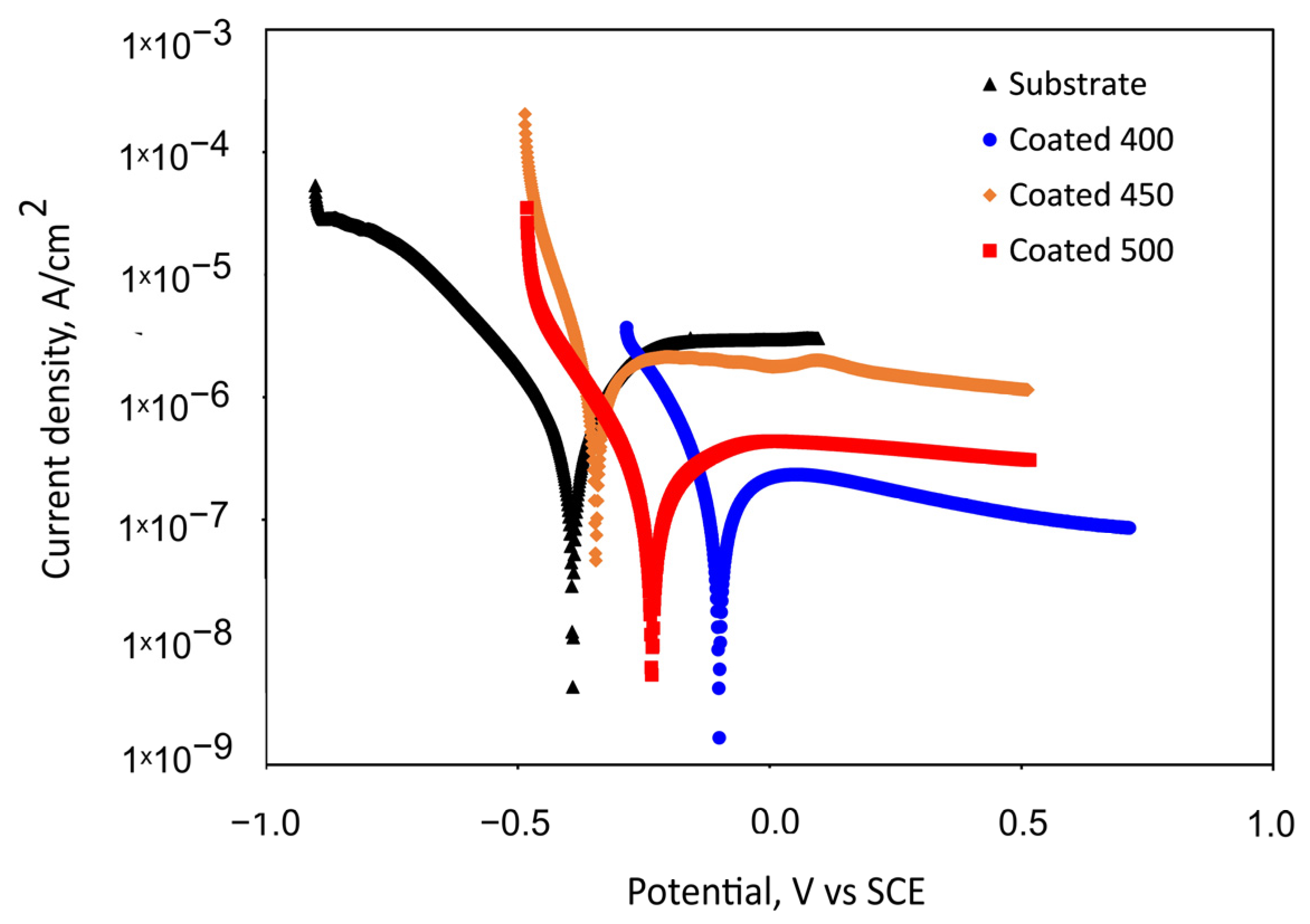


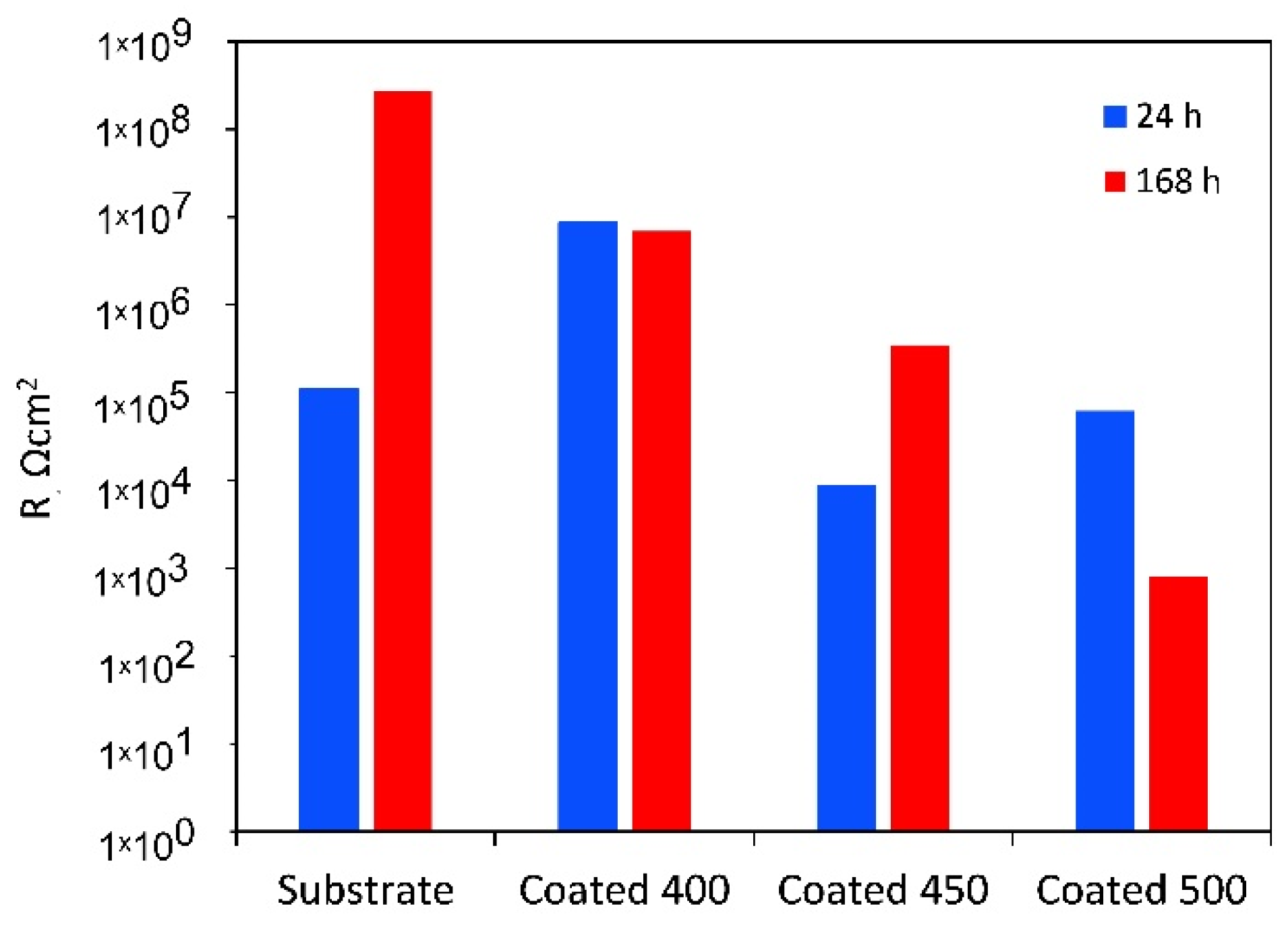
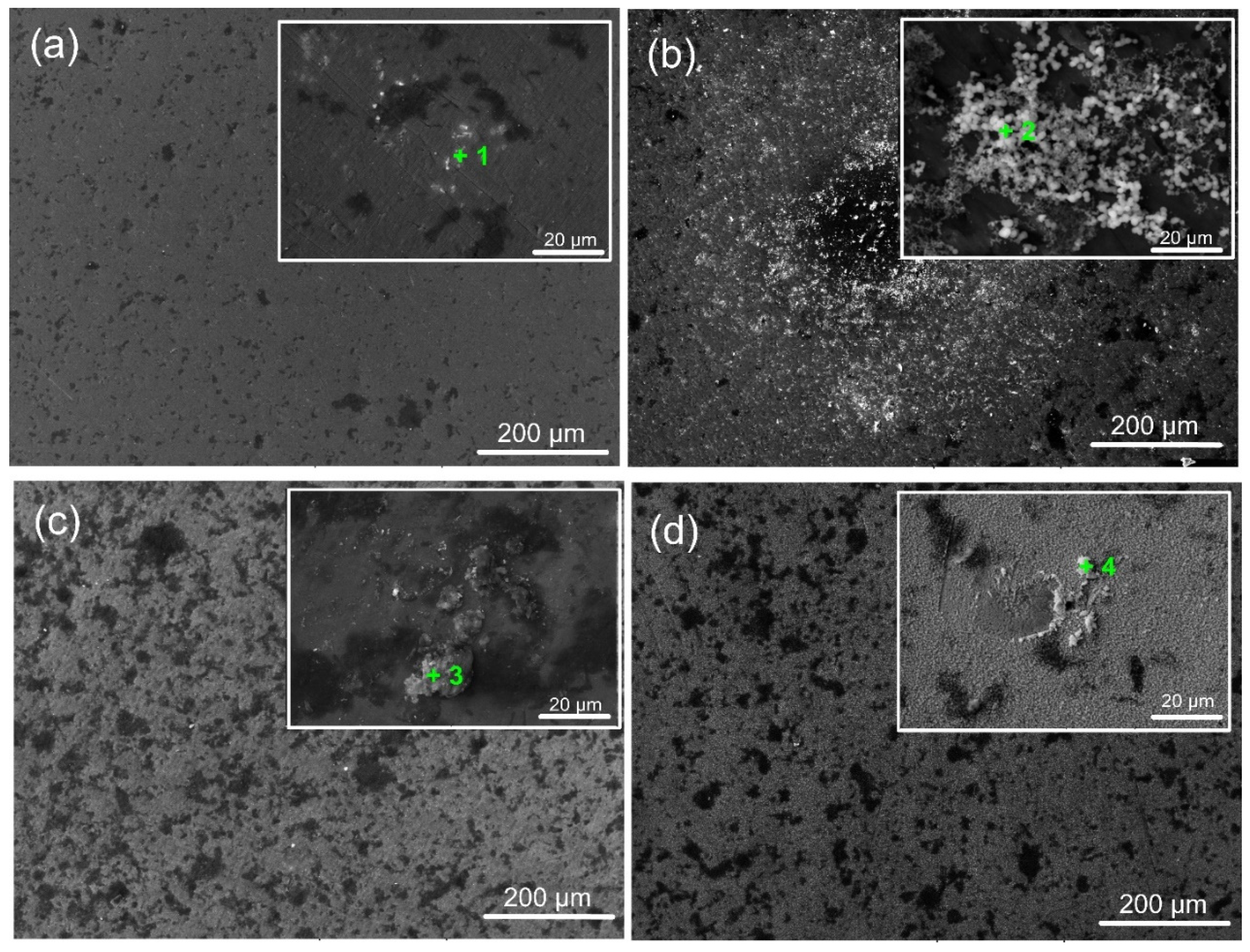
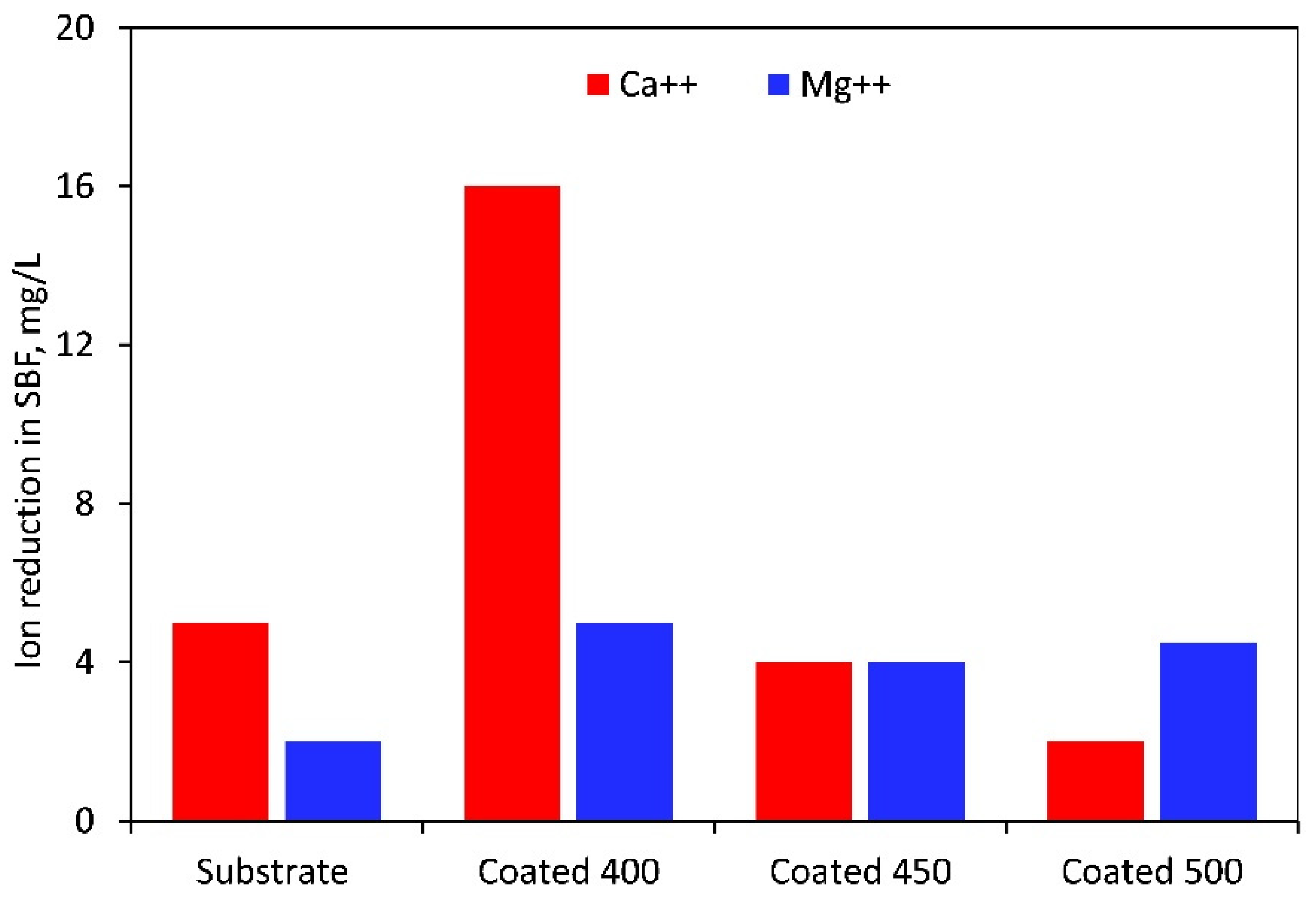
| Sample | Ta, at% ± SD | O, at% ± SD | O/Ta |
|---|---|---|---|
| Coated at 400 °C | 14.5 ± 2.2 | 61.3 ± 4.5 | 4.2 |
| Coated at 450 °C | 15.4 ± 1.9 | 57.5 ± 3.6 | 3.7 |
| Coated at 500 °C | 17.3 ± 0.7 | 46.9 ± 3.2 | 2.7 |
| Sample | HK0.005 (kgf mm−2) | Fc (N) | COF |
|---|---|---|---|
| Substrate | 561.5 ± 14 | - | 0.39 ± 0.02 |
| Coated at 400 °C | 1038 ± 20 | 8.6 ± 0.3 | 0.34 ± 0.04 |
| Coated at 450 °C | 1197.5 ± 63 | 9.9 ± 0.2 | 0.31 ± 0.06 |
| Coated at 500 °C | 1659.3 ± 67 | 20 ± 1.0 | 0.22 ± 0.03 |
| Sample | Ecorr (mV vs. SCE) | jcorr (10−6 A cm−2) | Rp (kΩ) | P.E. (%) |
|---|---|---|---|---|
| Ti6Al4V | −391 | 1.4 | 20.5 | - |
| Coated at 400 °C | −100 | 0.2 | 178 | 85.7 |
| Coated at 450 °C | −345 | 2.1 | 15.4 | - |
| Coated at 500 °C | −234 | 0.5 | 37.3 | 64.3 |
| Sample | Ti6Al4V | Ta2O5 400 °C | Ta2O5 450 °C | Ta2O5 500 °C | |||||
|---|---|---|---|---|---|---|---|---|---|
| Time | 24 h | 168 h | 24 h | 168 h | 24 h | 168 h | 24 h | 168 h | |
| Qp, (Ω−1cm−2sn) | 1.3 × 10−5 | 1.1 × 10−5 | 2.2 × 10−5 | 2.3 × 10−4 | 1.5 × 10−4 | 4.6 × 10−5 | 1.4 × 10−5 | 1.0 × 10−5 | |
| n1 | 0.91 | 0.91 | 0.64 | 0.45 | 0.69 | 0.60 | 0.88 | 0.85 | |
| Rp, (Ωcm2) | 1.1 × 105 | 2.7 × 108 | 7.2 × 102 | 1.9 × 104 | 8.8 × 103 | 9.2 × 101 | 4.4 × 101 | 1.2 × 102 | |
| Qb, (Ω−1cm−2sn) | 8.7 × 10−4 | 1.1 × 10−4 | 1.9 × 10−5 | 1.8 × 10−5 | 1.0 × 10−2 | 3.7 × 10−5 | 3.8 × 10−5 | 5.2 × 10−6 | |
| n2 | 0.53 | 0.52 | 0.85 | 0.84 | 0.76 | 1 | 0.86 | 0.86 | |
| Rb/Rpr, (Ωcm2) | 5.1 × 10−9 | 9.2 × 10−6 | 8.7 × 106 | 6.9 × 106 | 4.9 × 10−1 | 3.5 × 105 | 6.1 × 104 | 6.9 × 102 | |
| Qpr, (Ω−1cm−2sn) | - | - | - | - | 4.1 × 10−5 | 4.3 × 10−4 | 2.1 × 10−3 | 3.4 × 10−5 | |
| n3 | - | - | - | - | 1 | 0.47 | 1 | 1 | |
| Qpr, (Ω−1cm−2s0.5) | - | - | - | - | - | - | 2.1 × 10−3 | 1.3 × 10−4 | |
| W (s0.5) | - | - | - | - | - | - | 5.7 × 10−2 | 1.65 | |
| Sample | Ca | Mg | Na | P | O | Ca/P Ratio |
|---|---|---|---|---|---|---|
| Ti6Al4V | 5.4 | 0.15 | 1.47 | 3.6 | 92.1 | 1.50 |
| Coated at 400 °C | 6.7 | 0.4 | 1.5 | 4.4 | 79.2 | 1.52 |
| Coated at 450 °C | 6.3 | 0.3 | 0.96 | 4.56 | 81.3 | 1.38 |
| Coated at 500 °C | 1.3 | 0.3 | 1.4 | 0.9 | 82.5 | 1.44 |
| Samples | 1 Day | 3 Days | 7 Days |
|---|---|---|---|
| Substrate | 7.43 | 7.53 | 7.54 |
| Coated at 400 °C | 7.07 | 7.58 | 7.59 |
| Coated at 450 °C | 7.20 | 7.53 | 7.54 |
| Coated at 500 °C | 7.11 | 7.56 | 7.57 |
Disclaimer/Publisher’s Note: The statements, opinions and data contained in all publications are solely those of the individual author(s) and contributor(s) and not of MDPI and/or the editor(s). MDPI and/or the editor(s) disclaim responsibility for any injury to people or property resulting from any ideas, methods, instructions or products referred to in the content. |
© 2025 by the authors. Licensee MDPI, Basel, Switzerland. This article is an open access article distributed under the terms and conditions of the Creative Commons Attribution (CC BY) license (https://creativecommons.org/licenses/by/4.0/).
Share and Cite
Nikolova, M.P.; Tzvetkov, I. Influence of Deposition Temperature on Microstructure and Properties of Tantalum Oxide Sputtered Coatings. Materials 2025, 18, 1895. https://doi.org/10.3390/ma18091895
Nikolova MP, Tzvetkov I. Influence of Deposition Temperature on Microstructure and Properties of Tantalum Oxide Sputtered Coatings. Materials. 2025; 18(9):1895. https://doi.org/10.3390/ma18091895
Chicago/Turabian StyleNikolova, Maria P., and Iliyan Tzvetkov. 2025. "Influence of Deposition Temperature on Microstructure and Properties of Tantalum Oxide Sputtered Coatings" Materials 18, no. 9: 1895. https://doi.org/10.3390/ma18091895
APA StyleNikolova, M. P., & Tzvetkov, I. (2025). Influence of Deposition Temperature on Microstructure and Properties of Tantalum Oxide Sputtered Coatings. Materials, 18(9), 1895. https://doi.org/10.3390/ma18091895







